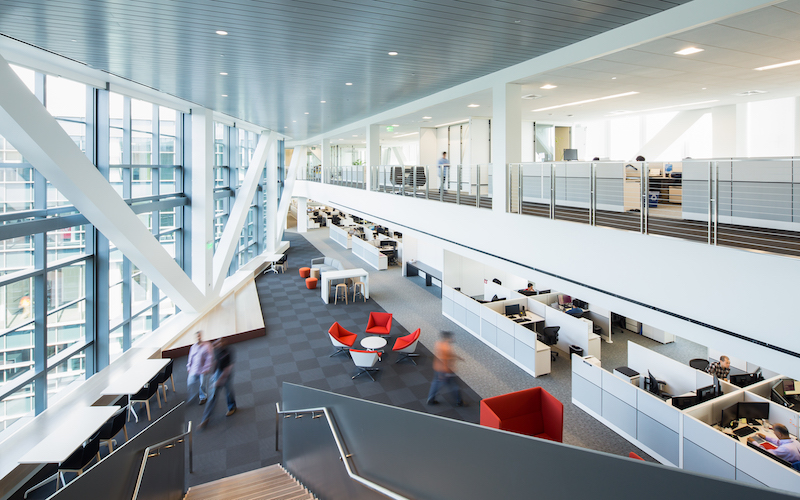
Building the Urban, Future Silicon Valley
Building the Urban, Future Silicon Valley
Samsung’s new office in San Jose sets the tone for Silicon Valley’s future developments.
San Francisco and Oakland have become increasingly attractive alternatives to Silicon Valley, as major tech firms—such as Twitter, Airbnb and Uber—build headquarters to appeal to a workforce that values vibrant, dynamic, authentic urban experiences. Today, less urbanized cities face a challenge in attracting and retaining top companies and talent.
San Jose, however, has taken notice. The city has been working hand-in-hand with forward-thinking companies to implement new urban design guidelines that move away from the traditional model of the isolated, suburban tech campus, in favor of a new ur-ban model that is connected, transit-oriented, sustainable and community-driven.
The new NBBJ-designed headquarters for Samsung Semiconductor Incorporated is an example of this effort. A 2,500-person, 1.1-million-square-foot R&D campus, it is located along North 1st Street, a strategic corridor for future development in San Jose. While the existing properties along North 1st Street are largely suburban in character, primarily isolated buildings surrounded by parking, the City of San Jose has an urban design plan to replace them, emphasizing street-fronting developments with minimal setbacks, retail and amenities to activate the pedestrian realm and taller buildings. Alt-hough several residential developments are following this pattern, Samsung is the first new corporate campus to do so.
So when Samsung approached NBBJ to design two 10-story office towers, we took the position that a vibrant workplace for today’s top talent would require buildings that interact more with each other and with the street. We pushed the towers together, creating the synergy they would otherwise have lacked, and moved them to the corner of North 1st Street and Tasman Drive, where they engage with two major arterial streets and two light-rail transit lines.
Here, the building meets the city’s desire for a more urban streetscape with public amenities at ground level. Two retail shops—a coffeehouse and a wine bar—will open later this year, and an adjacent incubator space is expected to forge connections between Samsung and the surrounding community. As well, a central, publicly accessible courtyard and the building’s main lobby bring additional energy to this corner of the city.
Placing the building against the intersection of North 1st and Tasman also frees up significant space for a publicly accessible landscape. Not only does this provide attractive outdoor space—which studies have shown puts people at ease and makes them work more creatively—it also yields sustainability benefits by creating a more permeable soil surface for rainwater runoff. All parking is located in a garage structure that forms a backdrop to this landscape.
As a result, the entire campus reflects the urban design guidelines for this area. The building’s massing and public amenities anchor the urban intersection of North 1st Street and Tasman Drive. As one moves west along Tasman Drive, the site transitions from urban to a campus-like environment and then to a public park in a microcosm of the area that provides different experiences for Samsung employees.
This additional benefit is a competitive advantage that San Jose holds over San Francisco: Variety. In our research, we discovered that while many younger workers do want an energetic, vibrant environment, others are happier in a place that allows them to focus on their work. Many Samsung employees, especially in the research department, happily live in the San Jose area—for some of them, relocating to downtown San Francisco would create a less successful work environment.
So the building is designed with layers of interaction. Employees can work in one of several two-story atriums, where they can interact and connect; or they can work in the central courtyard or roof gardens, where they can enjoy the outdoors and cross paths with other people; or they can work in the quiet laboratories, tucked on the far side near the elevators, along the edges of the building, away from the circulation and collaborative areas. There is a gradient of spaces from active to quiet, both inside and out.
As the San Jose Mercury News reported in 2014, the redevelopment plans for this area of North San Jose encompass 5,000 acres and an estimated $2.8 billion of new projects. As a longtime member of this community—having occupied this site for decades prior to building its new headquarters—Samsung has become the first company of many to commit to improving the quality of life of employees and the residents of San Jose. By embedding themselves more intimately with the surrounding urban fabric, companies like Samsung are not only promoting innovation within their own walls, they’re building the future of Silicon Valley itself.
Jonathan Ward, FAIA, LEED AP is a partner at NBBJ, a global architecture, planning and design firm with offices in Beijing, Boston, Columbus, Hong Kong, London, Los Angeles, New York, Pune, San Francisco, Seattle and Shanghai

